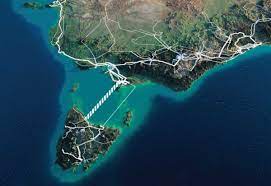
As Tasmanians head to the polls and many voting early, we do so with strikingly little clarity about the future of our energy system. And nowhere is that more alarming than in the case of Marinus Link, a nation-shaping project with state-shaking consequences. As outlined in a June 2025 Tasmanian Community Update:
Marinus Board delivers Final Investment Decision recommendation
On Friday, 30 May 2025, the Marinus Link Pty Ltd (MLPL) Board recommended that its shareholders make a Final Investment Decision to proceed with Stage 1 of Marinus Link.
The recommendation advises that there is a sound financial and economic investment case for proceeding with the construction phase of Marinus Link Stage 1, based on an assessment of forecast costs, revenue, associated benefits, and risks.
We really wouldn’t expect them to say anything contrary would we?
Our three shareholders, the Australian, Tasmanian and Victorian governments, will now undertake their own detailed analysis, due diligence, and risk assessments before issuing a formal Final Investment Decision in July 2025 (emphasis added).
…
Pending a positive Final Investment Decision, this marks the beginning of a series of detailed financial and regulatory steps before Marinus Link can proceed to the construction phase.
Following the successful completion of these important gateways, construction would commence in 2026. Despite its immense scale and significance, the Marinus decision process is now unfolding under the shadow of an election campaign, with key investment decisions by government-owned corporations likely already made behind closed doors. And yet, the Tasmanian public has still not seen the Whole-of-State Marinus Business Case, despite the promises, and weeks after the Minister confirmed its receipt.
This is not how decisions with multibillion-dollar implications for Tasmanian households, businesses and industries should be made.
For years, Marinus proponents have clung to one central narrative: that the project is a vital piece in the Australian Energy Market Operator’s (AEMO) Integrated System Plan (ISP) puzzle to achieve net zero by 2050. In this framing, Tasmania’s role is to plug in, power up, and accept the consequences, costs, risks, and all in service of the national good.
What’s been missing is any detailed, public exploration of Tasmania’s other options. What energy future do we want? What paths might we take that don’t require Tasmanians to foot the bill for interstate decarbonisation?
There has been no transparent comparison of alternatives, no public accounting of opportunity costs, and no clear articulation of the trade-offs involved. And due to Tasmania’s disaggregated energy structure, no one agency or authority has been charged with asking those questions, let alone answering them.
Hydro Tasmania, once the beating heart of the state’s energy system, now seems to be banking on Marinus as a catalyst that will seamlessly draw new private renewables into existence. But many of these projects are years from being shovel-ready and some may never materialise. Meanwhile, the Marinus transmission timetable marches on.
Only in early 2023 did the Minister finally acknowledge the interdependence of Marinus Link, the North West Transmission Developments (NWTD), Battery of the Nation (BotN), and new private sector wind and solar projects. Treasury and Renewables, Climate and Future Industries Tasmania (ReCFIT) were then charged with developing a Whole-of-State Business Case to guide final investment decisions.
On 16 May 2025, the Minister confirmed receipt of that business case. He also announced that TasNetworks and Hydro Tasmania would make their final calls by the end of May. After that? Just 30 days of public access to the Whole-of-State Business Case before the State Government and the Marinus Pty Ltd Board sign off on the Final Investment Decision (FID).
In other words, it’s highly likely those corporate decisions are already locked in. And yet the public still hasn’t seen the rationale behind them.
The original Marinus pitch gave Tasmania a far sweeter deal: just 6% of the project’s benefits, and therefore only 6% of the costs. But as the story shifted from national ambition to regional necessity, so too did the financial allocation.
Today, under the current intergovernmental agreement, Tasmania is on the hook for 27.6% of the project’s regulated cost recovery, with Victoria picking up the remaining 72.4%. No other state is paying.
This isn’t just unfair, it’s unfathomable when considered against the relative size of our population, economy, and energy consumption.
The message is clear: Tasmanians will now underwrite nearly a third of a multi-billion dollar national transmission asset, without the assurance of a clear long-term benefit to our own economy or energy users.
And here’s the kicker: even if the Tasmanian Government sells its 17.7% equity stake in Marinus (worth around $125 million) to the Commonwealth and Victoria, that does nothing to change our annual cost recovery obligations under the AER rules.
We lose ownership—but we still pay the bill.
To truly grasp the risks, we need only to check Marinus’s underwater cousin, BassLink. Launched in 2006, BassLink never lived up to its economic or technical hype. The link failed, went into receivership, was sold for $773 million (down from its $875 million construction cost), and has cost Tasmanians dearly in lost generation, arbitrage losses, and protracted legal disputes, many of which we did recoup thankfully. We are yet to get a full account of what happened. What we know is that it was promoted as a way to make money by net exporting, but proved to be of most value as a net importer propping up our hydro system.
Now, with Marinus Stage 1 forecast to cost $3.5 billion for 750MW of capacity, on top of $950 million for NWTD Stage 1, we’re expected to believe this project is a sounder bet? As an importer? An exporter? We do know that costs are likely to end up being even higher, as construction costs continue to escalate and will be passed on to consumer via higher prices.
It’s a hard sell.
Marinus and NWTD together could add at least $90-100 million annually (based on concessional finance provided by the Federal government), if not more, to the bills of Tasmanian electricity customers. Of that, around 25 per cent would fall to residential users—roughly $100 per household. The other 75 per cent would fall to commercial and industrial users, many of whom are already under serious pressure from volatile global markets and thin operating margins.
There is no public evidence to show how this burden will be managed. Will the state government offer subsidies? Will businesses pass costs on to consumers—or simply leave the state?
And that’s before factoring in BassLink’s recent transition to a regulated asset which will add more to Tasmanian bills. Based on existing TasNetworks – Transmission allowable cost recovery, the Regulator is likely to allow Basslink to recover some $75 million from Tas and Vic electricity consumers and based on a 25/75% split proposed by the new owner APA, similar to that agreed for Marinus, a quarter of that ($19 million) will be paid by Tasmanian consumers.
Add it all together, and the picture becomes stark: likely $120 million in new electricity charges annually, with no clear long-term benefit guaranteed.
Should Marinus falter, whether due to delays, cost overruns, or insufficient revenue, the risk doesn’t evaporate. It lands squarely on Tasmania.
TasNetworks, Hydro Tasmania and Marinus Link Pty Ltd could all require public bailouts to stay afloat. The state budget would come under pressure. Electricity affordability would suffer. And Tasmania’s energy system could be reshaped in ways we can’t yet foresee.
We are not Snowy Hydro, with deep Commonwealth pockets and national political insulation. We are a small state with limited capacity to absorb risk. If Marinus is indeed a nation-building project, then the nation, not Tasmania, must carry the lion’s share of the risk.
That means full Commonwealth underwriting. It means a regulated asset model that protects Tasmanians from cost blowouts. And it means subsidies and guarantees—up front, not after the damage is done.
In addition,since Marinus was first modelled, the landscape has changed. Transmission construction costs have surged, up 55% in just two years, according to a recent report in RenewEconomy. Projects like Snowy 2.0 are billions over budget. Community opposition is mounting across regional Australia. And new technologies, from grid-scale batteries to distributed energy systems, are eroding the old logic of centralised transmission planning.
Meanwhile, hydro inflows in Tasmania are historically low. That alone should trigger a rethink of the “Battery of the Nation” branding. Our storage capacity may not be as bankable as we once believed. Thus, the assumptions underpinning Marinus may no longer be solid.
There is still time, but not much. Before the State commits to a Final Investment Decision, the Whole-of-State Business Case must be released. Tasmanians deserve a full accounting of the risks, the costs, and the alternatives.
We need independent modelling. We need scrutiny. We need transparency.
And above all, we need a government with the courage to say: “Not yet.”
Marinus may yet be part of our energy future. But right now, we simply can’t afford to get it wrong.

